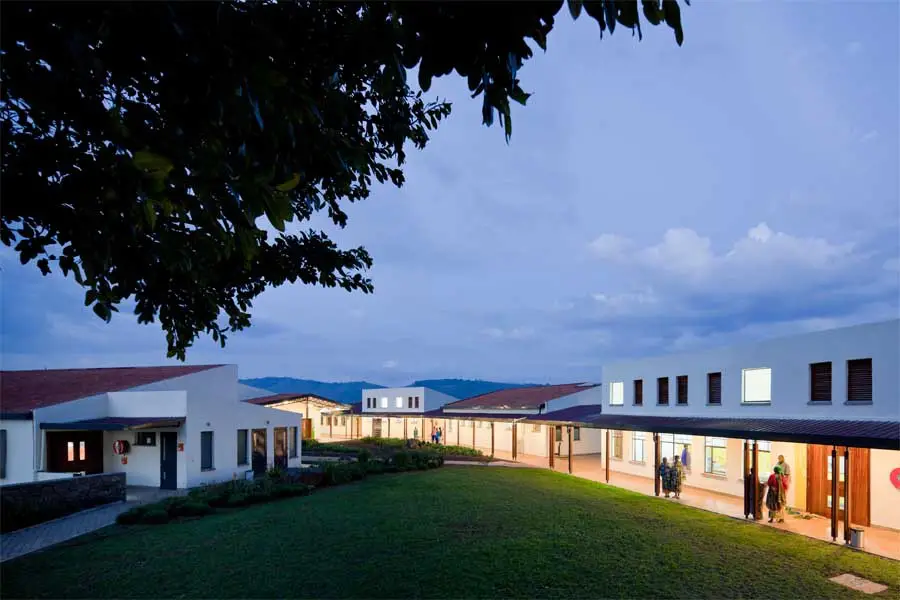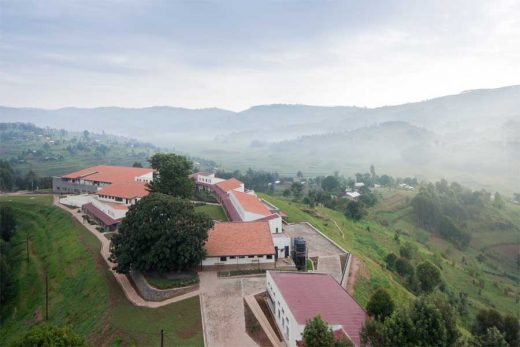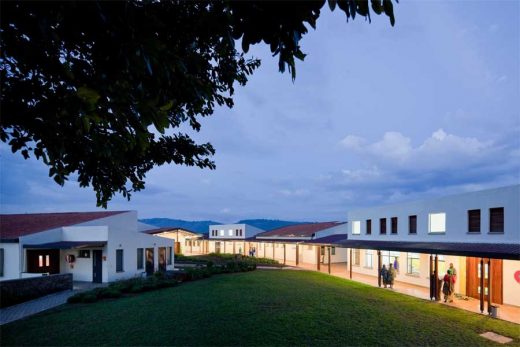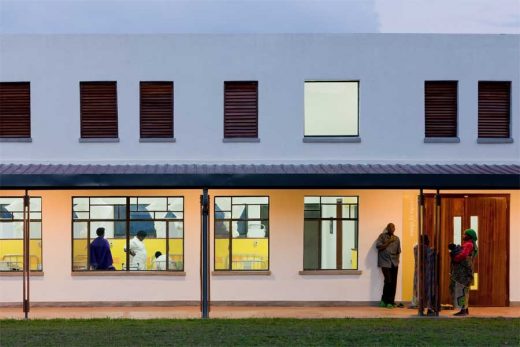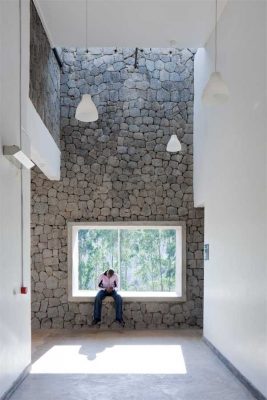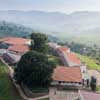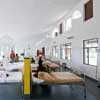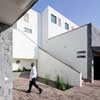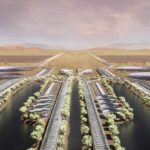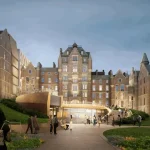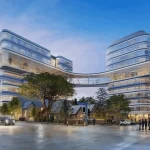Butaro Hospital Burera, Rwanda Health Building, Partners In Health Design
Butaro Hospital, Africa : Rwanda Building
African Health Architecture by MASS Design Group
18 Aug 2011
Butaro Hospital, Burera District, Rwanda
Design: MASS Design Group, USA
Photos by Iwan Baan
Butaro Hospital Rwanda
Butaro Hospital – Overview
In January 2011, the Rwandan Ministry of Health and Partners In Health (PIH) opened the 140-bed Butaro Hospital in the Burera District of Rwanda. Burera District, which has a population of over 340,000, has historically had very poor health indicators compared to other areas of Rwanda and is one of the most impoverished districts in the country. Prior to PIH’s arrival in 2007, Burera was one of the last two districts in the country without a functioning district hospital and was without a single doctor. MASS Design Group was brought in by PIH in 2008 to help plan and design a first-rate facility that would help reverse these conditions.
In the design of the hospital, MASS Design Group and PIH sought to create a more holistic model of architecture that included the design of an appropriate, state-of-the-art hospital while also fully choreographing the process of construction to employ, educate and empower the local community.
Infection Control
After immersion in the field through living and working at the Butaro Health Center, and consultation with global health experts from PIH, Harvard School of Public Health, Harvard Medical School, and the Center for Disease Control, the issue of nosocomial or hospital-borne infection became apparent. Due to crowded corridors and insufficient ventilation, patients and healthcare providers were often subjected to the high risk of contracting airborne diseases inside health facilities, particularly in rural, impoverished settings. The design of Butaro sought to mitigate and reduce the transmission of airborne disease through several systems, including overall layout, patient and staff flow, and natural ventilation, providing a template and approach that could be replicated in areas of high risk for TB transmission and other airborne diseases in resource-limited settings.
The Butaro Hospital design incorporates a range of innovative features designed to minimize risk of infection. Elimination of interior corridors and installation of large-radius fans and louvered windows ensure frequent air exchange, a key strategy in reducing transmission. In order to produce the necessary air changes in the ward, high-volume, low-speed fans with diameters of 24 feet were used at strategic points to move air from the wards out the louvers and open windows, and in doing so remove potentially harmful microbes. Germicidal UV lights were installed to kill or inactivate microbes as air is drawn through the upper regions of the room. Finally, the use of a non-permeable, continuous floor finish provided a surface devoid of joints prone to bacterial growth. The floor type is easy to clean, durable, and safe by resisting infection.
Capacity Building
Beyond providing access to first-rate healthcare facilities, the Butaro Hospital project was used as a way to spur grassroots business and development. Constructed with 100% local labor, 3,898 people were trained and hired to help excavate, construct, and manage the project. Construction teams were organized into six teams, each of which worked a two-week shift. This allowed for six times as many people to be hired and be involved in the building process. All employees were provided with food, water, and healthcare. Employing more laborers was cheaper and faster than using solely heavy equipment to excavate the hillsides and move the earth — but more importantly, it provided the added benefits of both creating jobs and engendering community investment in the project.
Masonry
Capacity building and two-way learning happened naturally at all stages and areas of the project, from design workshops with the local builders through on-site development of specific construction methods. Volcanic stone is a ubiquities element of the northern Rwandan landscape; commonly thought of as a nuisance by farmers clearing their fields. When used in building, it is typically only for foundations or courtyard walls, and is often covered partially or completely with mortar. In an effort to reveal the exceptionally unique and beautiful texture of the stone we sought to minimize mortar, and create an even and nearly seamless expanse of deep gray porous walls.
After multiple mock-ups, the mason’s began to get excited about the product that was appearing, and finally were given the goahead. As they progressed through the various buildings on the hospital campus, their work became more and more refined. Recognizing how their skill had advanced as they worked, the masons eventually offered to replace their initial work at no cost, out of a sense of pride. As newly trained, highly skilled contractors, these masons are now sought after in other parts of the country by contractors seeking to replicate the “magnificent stone walls of Butaro.”
Metrics of Success
Burera District Before:
•Prior to 2007 one of the last districts in Rwanda without a hospital
•Population: 340,000
•Physicians: 0
Construction:
• Trained: 3,898 Laborers
• Income distributed using Butaro labor: $553,800 USD
• Cost: 2/3 cost of typical MoH Hospital per sqft
Burera District After:
• Nearly 1,500 trained community health workers in every village in the district
• 12 physicians on staff
Amenities:
-140 new ward beds
– 2 Operating Rooms and 1 emergency procedure room
– Fully equipped lab
– Neonatology unit, planned for 4 incubators and a mother and childcare area.
– Post-maternity ward
– Delivery ward with 4 beds, one emergency procedure room, and 2 infant resuscitation tables
– ER with 4 trauma bays
– 10 isolation rooms for patients with highly infectious diseases
– Referral clinic rooms for gynecology, ENT, Oncology, Physical Therapy, Ophthalmology
– Oxygen generating plant with oxygen piped to the bedside
– Two digital X-ray system
– The district’s first comprehensive mental health clinic and inpatient facility
Future Growth:
•Fall 2011: Hospital will run on 100% hydro-electric power from a newly constructed dam located one mile from the facility in Rusumu.
• Fluid dynamics experts predict an air-change rate of approximately 12 air changes per hour in wards. This improvement is anticipated to reduce nosocomial transmissions by 35% as has been seen in comparable cases.
Butaro Hospital Rwanda – Building Information
Architects: MASS Design Group
Design Team: Michael Murphy, Alan Ricks, Sierra Bainbridge, Marika Clark, Ryan Leidner, Garret Gantner, Cody Birkey, Ebbe Strathairn, Maura Rockcastle, Dave Saladik, Alda Ly, Robert Harris, Commode Dushimimana, Nicolas Rutikanga
Structural Engineering: ICON
Construction Supervision: PIH/IMB, Bruce Nizeye, Felix Ndagijimana
Sewage Plant Engineering: EcoProtection
Landscape Design: Sierra Bainbridge and Maura Rockcastle
Client: Rwandan Ministry of Health; Partners In Health / Inshuti Mu Buzima
Built Area: 6,040 square meters
Cost: $4.4M
Design Phase: Jan 2008 – Feb 2009
Construction Phase: Feb 2009 – Jan 2011
Butaro Hospital Rwanda information from MASS Design Group
Butaro Hospital Rwanda images from FD
Photos : Iwan Baan
Location: Rwanda, Africa
A recent Rwanda building design on e-architect:
Kigali Green City Project, Rwanda
Design: Feilden Clegg Bradley Studios + regional architects Light Earth Designs, A Studio Space and Studio FH Architects
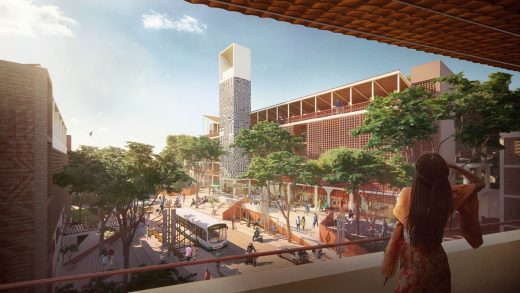
image : FCBS
Kigali Green City Project
Another new Rwanda building on e-architect:
Education Center Nyanza
2010
Architects: Dominikus Stark Architekten
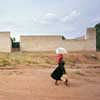
Rwanda Education Center image from Dominikus Stark Architekten
Rwanda Education Center
The Central African State of Ruanda, commonly known as the “land of a thousand hills”, is rarely the focus of West European interests. On a private initiative, on the road in Nyanza connecting the country’s most important towns Kigali und Butare, a new Education Center has been built. While the initial order was to design a new roof over a forecourt, after first discussions the idea was born to build a training center with lighthouse character, with a future-oriented curriculum and training options.
Africa Architecture
Africa Architectural Projects
Calabar International Center, Nigeria
Henning Larsen Architects
Calabar International Center
Melaku Center, Tigray, Ethiopia
Architect: Xavier Vilalta
Ethiopian Building
Architectural Design
Contemporary Building Designs – recent architectural selection from e-architect below:
Burkina Faso Secondary Schools
Comments / photos for the Butaro Hospital Rwanda building design by MASS Design Group page welcome

